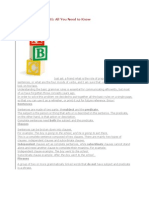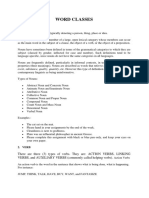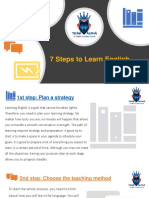Grammar - Grade 7
Grammar - Grade 7
Uploaded by
Saira FaisalCopyright:
Available Formats
Grammar - Grade 7
Grammar - Grade 7
Uploaded by
Saira FaisalOriginal Description:
Original Title
Copyright
Available Formats
Share this document
Did you find this document useful?
Is this content inappropriate?
Copyright:
Available Formats
Grammar - Grade 7
Grammar - Grade 7
Uploaded by
Saira FaisalCopyright:
Available Formats
The City School
Mirpur Khas Campus
Grammatical terminologies
1. Connectives are words or phrases that link sentences (or clauses) together.
Types of connectives:
Correlative: Working in pairs (example: either/or, both/and, not only/but also, as/as) to join phrases or words that carry equal importance within a sentence. E.g.: I not only passed the exam, but also got 100%.
Coordinating: Coordinating conjunction joins two main clauses or two complete sentences – both parts of the sentence can stand alone. There are 7 coordinating conjunctions: for, and, nor, but, or, yet, so. They
can be remembered using the acronym FANBOYS. E.g.: I stayed up all night writing, so I was tired the next day.
Subordinating: Subordinating conjunctions are one or more words that unite ideas in a complex sentence (example: as soon as, in case, unless, while). They link dependent clauses (incomplete thoughts) to
independent clauses (complete thoughts).E.g.: As soon as she’s finished her phone call, we’ll leave for the restaurant.
2. Phrase: A phrase is a small group of words that adds meaning to a sentence. A phrase is not a sentence because it is not a complete idea with a subject and a verb.
Noun phrase: A noun phrase is a group of words that have a noun or pronoun. It is used to modify the noun. In other words, it can be said that a noun phrase can function as a subject, an object or a complement
in a sentence.: E.g., My brother’s friend, red box, a decent black shirt.
A prepositional phrase is a group of words consisting of a preposition, its object, and any words that modify the object. Most of the time, a prepositional phrase modifies a verb or a noun. Mark is going out with
that beautiful woman.
An embedded clause is a clause used in the middle of another clause to give the reader more information about a sentence. Embedded clauses rely on the main clause and don't make sense in isolation. We
separate embedded clauses from the main sentence with punctuation on either side of the clause. This can be commas (,), dashes (—), or brackets (()). E.g. The coat, which was old, had a hole in the pocket.
3. Figure of speech:
A simile is a figure of speech that compares two unlike things and uses the words “like” or “as” and they are commonly used in everyday communication. E.g., The boy was as brave as a lion in the jungle.
A metaphor compares two different things, similar to a simile. The main difference between a simile and a metaphor is that metaphors do not use the words “like” or “as.”
Personification is giving human characteristics to nonhuman or abstract things. This could be physical attributes (“the eye of the needle”), emotional attributes (“a single lonely shoe”), or human actions (“a
leaf dancing in the wind”).
Sibilance is a type of literary device and figure of speech wherein a hissing sound is created in a group of words through the repetition of ‘s’ sounds. For example, “Sarah’s silly sister swallowed her sweet.”
It is important to remember that sibilance is all about the ‘s’ sound, not the letter ‘s’ itself.
Assonance is a figure of speech in which the same vowel sound repeats within a group of words. An example of assonance is: "I might like to take a flight to an island in the sky."
Oxymoron is a figure of speech pairing two words together that are opposing and/or contradictory. Only choice, Same difference
Imagery is language used by poets, novelists and other writers to create images in the mind of the reader. Imagery includes figurative and metaphorical language to improve the reader’s experience through
their senses.The grass was green and the flowers were red.
1. Prefix: Group of words added to the beginning of a word to modify its meaning. (e. g., resubmitted, antilock, hyperactive).
2. Suffix: Groups of words added to the end of a word to modify its meaning or change it into a different word class. (e. g., Biology, happiness, helpful).
3. Reported speech:
Direct speech repeats, or quotes, the exact words spoken. When we use direct speech in writing, we place the words spoken between quotation marks (" ") and there is no change in these words (e.g., He said, "I
am fine”).
Reported or indirect speech is usually used to talk about the past, so we normally change the tense of the words spoken. We use reporting verbs like 'say', 'tell', 'ask', and we may use the word 'that' to introduce the
reported words. Inverted commas are not used (e.g., He said that he was fine”).
Rhyme: Two words that end with the same sound are said to rhyme. For example, words like bell and well share the same ending.
Rhythm is the pattern of language in a line of a poem, marked by the stressed and unstressed syllables in the words.
Punctuation marks:
Exclamation mark: The! is called an exclamation point. Exclamation points are punctuation marks that show a sudden outcry in writing. They also emphasize a point more strongly than a period. Sudden outcry -
"Holy cow!" screamed Jane. To emphasize a point - My mother-in-law's rants make me furious!
Semicolon: The ; is called a semicolon. Semicolons are punctuation marks that connect independent clauses to show a closer relationship between the clauses than a period would. They can also separate items in a
list that already include commas. Connecting independent clauses - John was hurt; he knew she only said it to upset him. Items in a list - I’ve visited Cleveland, Ohio; Los Angeles, California; and St. Louis,
Missouri.
Colon: The: is called a colon. Colons introduce a quotation, an explanation, an example, or a series. They can also clarify information or emphasize an important word or phrase. Introducing a series - He was
planning to study four subjects: politics, philosophy, sociology, and economics. Clarifying information - I didn't have time to get changed: I was already late. Emphasizing an important phrase - There was one thing
she loved more than any other: her dog.
The ellipsis (…) is a type of punctuation that represents a pause or that something has been intentionally left out.
Pronouns:
First person pronouns are used by a speaker or a writer or a group to refer to himself or herself or themselves. E.g. I, me, my, mine, myself, we, us, our, ours, ourselves.
Second person pronouns refer to the reader or listener. A writer should use second person pronouns when speaking directly to the reader. E.g. you, your, yours, yourself, yourselves.
A third person pronoun is a pronoun that refers to an entity other than the speaker or listener. Mainly, third person pronouns refer to people or object not directly involved. E.g. he, him, his, himself, she,
her, hers, herself, it, its, itself, they, them, their, theirs, themselves.
Types of noun:
A proper noun is a name which refers only to a single person, place, or thing and there is no common name for it. In written English, a proper noun always begins with capital letters. Example: Melbourne,
James
A common noun is a name for something which is common for many things, person, or places. It encompasses a particular type of things, person, or places. Example: Country, city, sea
An abstract noun is a word for something that cannot be seen but is there. It has no physical existence. Generally, it refers to ideas, qualities, and conditions. Example: Truth, lies, happiness, sorrow,
A concrete noun is the exact opposite of abstract noun. It refers to the things we see and have physical existence. Example: Chair, table, bat, etc.
Countable noun: The nouns that can be counted are called countable nouns. Countable nouns can take an article: a, an, the. Example: Chair, table.
Uncountable noun: The nouns that cannot be counted are called non-countable nouns. Example: Water, sugar, oil, salt, etc.
A collective noun is a word for a group of things, people, or animals, etc. Example: family, team, jury, cattle, etc.
Sentence structure is a grammatical component that tells you exactly where and how each component of a sentence should be placed in order to blend and make sense.
Components of a sentence: Like a sentence has two parts, it has five main components that make up the structure of a sentence, and they are,
Subject, Verb, Object, Complement, Adjunct
Subject: A noun that performs the action in a sentence is considered as the subject. It answers the question ‘who’ or in other words, a subject can be identified by asking the question ‘who’. e.g. The
child kept crying. My son is in the eighth grade..
Verb: A verb shows action or activity or work done by the subject. e.g. Neena is writing a letter. It was too dark
Object: An object is a noun or pronoun that receives the action done by the subject.
Complement: The words required to complete the meaning of a sentence can be referred to as the complement of the sentence. A complement can be an adjective, a name, a position or a profession. e.g. It
grew dark. He is a dentist.
Adjunct: An adjunct is a word or a phrase that gives more information about an action, an event, a quality and so on. In short, it can be said that these words can include adverbs and adverb clauses. Adjuncts can be
identified by asking questions ‘when’, ‘where’, ‘why’, ‘how’, ‘how often’ and ‘to what extent’. e.g. Yesterday, we met at the park.. He is very tired.
SV
The stars / are shining.
Subject / Verb
It / is raining.
Subject / Verb
SVO
Children / love / ice creams.
Subject / Verb / Object
I / have / a pencil.
Subject / Verb / Object
SVC
I / am / an Indian.
Subject + Verb + Complement
Carol / is / a nurse.
Subject + Verb + Complement
SVA
Ali / reached / early.
Subject / Verb / Adjunct
He / went / upstairs.
Subject / Verb / Adjunct
You might also like
- OET B1 Progress Test Unit 1 A + BDocument9 pagesOET B1 Progress Test Unit 1 A + BMasha UvNo ratings yet
- English Grammar 101Document21 pagesEnglish Grammar 101Dharmarao BalagaNo ratings yet
- Billy Clark - Pragmatics - The Basics (2021, Routledge)Document211 pagesBilly Clark - Pragmatics - The Basics (2021, Routledge)Cilvia Ramadhoni100% (1)
- English Grammar All You Need To KnowDocument22 pagesEnglish Grammar All You Need To KnowDavid Fueter0% (1)
- 5th Grade Ela Study GuideDocument5 pages5th Grade Ela Study Guideapi-292325707100% (7)
- English Grammar 101Document8 pagesEnglish Grammar 101Chris Hogan100% (1)
- English Oh ReadDocument115 pagesEnglish Oh Readjoc3lyn_nNo ratings yet
- Gramatyka Opisowa (Ściąga)Document64 pagesGramatyka Opisowa (Ściąga)Adam DmochowskiNo ratings yet
- English Basic GrammarDocument12 pagesEnglish Basic GrammaribnuamungNo ratings yet
- Types of Parts of Speech NounDocument20 pagesTypes of Parts of Speech NounNurul Aida NionsiNo ratings yet
- Sentences: Independent Clauses Act As Complete Sentences, While Subordinate Clauses Cannot Stand Alone andDocument9 pagesSentences: Independent Clauses Act As Complete Sentences, While Subordinate Clauses Cannot Stand Alone andThamizhman Mani100% (1)
- Grammar 101Document14 pagesGrammar 101Reza Ayah MaharaniNo ratings yet
- Purposive Communication.Document8 pagesPurposive Communication.Kyla Ramos Diamsay100% (1)
- Review Ee ErrrrDocument15 pagesReview Ee ErrrrJessica CasipitNo ratings yet
- The Process of Sending and Receiving Messages Through Verbal or Nonverbal Means - (Oral (Written Communication),, Signals, or BehaviorDocument7 pagesThe Process of Sending and Receiving Messages Through Verbal or Nonverbal Means - (Oral (Written Communication),, Signals, or BehaviorAyaba RoselynNo ratings yet
- English Grammar 101Document10 pagesEnglish Grammar 101Talibovic TalibovNo ratings yet
- Road To English BetterDocument65 pagesRoad To English BetterEko Nurhadi SatrioNo ratings yet
- Parts of Speech in EnglishDocument13 pagesParts of Speech in EnglishApparel ShopNo ratings yet
- All About GrammarDocument56 pagesAll About GrammarDeka Fab100% (1)
- The Sentence of EnglishDocument16 pagesThe Sentence of EnglishBilal HassanNo ratings yet
- Basic EnglishDocument4 pagesBasic EnglishwuhemosesNo ratings yet
- Parts of SpeechDocument32 pagesParts of Speechkpb5n9yxsfNo ratings yet
- English GrammarDocument21 pagesEnglish Grammar232No ratings yet
- Grammar and Punctuation: The Parts of SpeechDocument2 pagesGrammar and Punctuation: The Parts of SpeechjonfoukNo ratings yet
- Sentence StructureHandoutDocument42 pagesSentence StructureHandoutCNo ratings yet
- English GrammarDocument21 pagesEnglish Grammarcontact.asif.directNo ratings yet
- Skill FinalDocument37 pagesSkill Finalkalai cgmNo ratings yet
- Parts of SpeechDocument18 pagesParts of SpeechSakunthala RajeshNo ratings yet
- The 8 Parts of SpeechDocument6 pagesThe 8 Parts of SpeechGlycel Angela JacintoNo ratings yet
- Reviewer in English 3Document5 pagesReviewer in English 3montalbanpsalm.gNo ratings yet
- Basic Com. Information Sheet.1.1-1 Part of SpeechDocument5 pagesBasic Com. Information Sheet.1.1-1 Part of SpeechJhoerey D VillegasNo ratings yet
- Overview of Different Parts of SpeechDocument11 pagesOverview of Different Parts of Speechbenbelkacem.israaaNo ratings yet
- Bahasa Inggris Bisnis 1Document59 pagesBahasa Inggris Bisnis 1Agung Junaedy100% (1)
- Word ClassificationDocument28 pagesWord ClassificationmiftaNo ratings yet
- English Unit 2Document21 pagesEnglish Unit 2james rareNo ratings yet
- Topic 1 Grm. Parts of SpeechDocument17 pagesTopic 1 Grm. Parts of SpeechHafizNo ratings yet
- The Parts of SpeechDocument2 pagesThe Parts of SpeechDinesh VoraNo ratings yet
- The Eight Parts of SpeechDocument7 pagesThe Eight Parts of SpeechJasmin Binauhan Niegos-Trongco100% (1)
- Meaningful Building-Block of Language: Name: Ajeng Yupika NIM: 1185030011 Class: 3ADocument7 pagesMeaningful Building-Block of Language: Name: Ajeng Yupika NIM: 1185030011 Class: 3AAjeng YupikaNo ratings yet
- Parts of Speech-Nivashini Tuition ClassDocument22 pagesParts of Speech-Nivashini Tuition ClassNivasini gunasekaranNo ratings yet
- Parts of SentencesDocument14 pagesParts of SentencesAkirun HarahapNo ratings yet
- Parts of SpeechDocument19 pagesParts of Speechzafar iqbalNo ratings yet
- English Parts of SpeechDocument4 pagesEnglish Parts of Speechnuril khoirina08No ratings yet
- The Parts of SpeechDocument2 pagesThe Parts of SpeechErmie SoleroNo ratings yet
- Gramma IDocument49 pagesGramma ITesfu HettoNo ratings yet
- Grammatical ConceptsDocument38 pagesGrammatical Conceptsjoy canda50% (2)
- Sentence AnalysisDocument32 pagesSentence AnalysisSPECIFIED With SIMFLIFICATIONNo ratings yet
- The Parts of SpeechDocument4 pagesThe Parts of SpeechMarnie PoHanNo ratings yet
- Parts of Speech in EnglishDocument23 pagesParts of Speech in EnglishNina fauziah100% (2)
- Part of Speech OverviewDocument44 pagesPart of Speech OverviewSufyan Ashraf100% (1)
- Soe ReviewerDocument23 pagesSoe ReviewersymerdavedangoNo ratings yet
- Previous year question papers and notesDocument28 pagesPrevious year question papers and notesanaghasurendran967No ratings yet
- Sentences: (TUTORIAL) All About Grammars & TensesDocument69 pagesSentences: (TUTORIAL) All About Grammars & Tenses3vilcatNo ratings yet
- The Parts of SpeechDocument4 pagesThe Parts of SpeechNarcysNo ratings yet
- English GrammarDocument48 pagesEnglish GrammarEhsanullah RahimiNo ratings yet
- Stucture Word ClassesDocument10 pagesStucture Word ClassesDwiNo ratings yet
- What Does It Mean To Know A WordDocument5 pagesWhat Does It Mean To Know A WordAlthea Mae GelacioNo ratings yet
- Parts of SpeechDocument6 pagesParts of SpeechKenneth ReyesNo ratings yet
- Comprehensive English Grammar Guide: From Basics to Competitive ExcellenceFrom EverandComprehensive English Grammar Guide: From Basics to Competitive ExcellenceNo ratings yet
- A Deep Dive Into Nouns : A Beginner Study To All Forms of NounsFrom EverandA Deep Dive Into Nouns : A Beginner Study To All Forms of NounsNo ratings yet
- 7 Days to Grammar Excellence: How to Master English from Beginner to AdvancedFrom Everand7 Days to Grammar Excellence: How to Master English from Beginner to AdvancedNo ratings yet
- Class-4 Maths1Document3 pagesClass-4 Maths1duttapriyanshu200423No ratings yet
- Adverbs (Microsoft Forms)Document6 pagesAdverbs (Microsoft Forms)Jamie CayabyabNo ratings yet
- Knowing How To Get There: Is AnyDocument10 pagesKnowing How To Get There: Is AnyLuisNo ratings yet
- Bongat ConnieDocument1 pageBongat ConnieJoenel PabloNo ratings yet
- Lesson Plan Future TenseDocument3 pagesLesson Plan Future TenseHimaniNo ratings yet
- PC 4Document1 pagePC 4Діана КостенюкNo ratings yet
- Simple Past TenseDocument6 pagesSimple Past TensetarijawaNo ratings yet
- Instapdf - in Way To Success 11th English Guide 794Document139 pagesInstapdf - in Way To Success 11th English Guide 794Chellaiah CSNo ratings yet
- Malayalam Proverbs - WikiquoteDocument7 pagesMalayalam Proverbs - WikiquotePraveen K50% (4)
- A Detailed Lesson Plan in EnglishDocument5 pagesA Detailed Lesson Plan in EnglishDonna GeonzonNo ratings yet
- Arabic Diglossia - Jeremy PalmerDocument15 pagesArabic Diglossia - Jeremy PalmerTaliba RoumaniyaNo ratings yet
- Asma G.SDocument5 pagesAsma G.SAfia FaheemNo ratings yet
- Filipino Play ScriptDocument23 pagesFilipino Play ScriptMarianne DomingoNo ratings yet
- A Phone Call From A CustomerDocument2 pagesA Phone Call From A CustomerCecilia Scarlett Arriagada SanchezNo ratings yet
- AECC ScienceDocument8 pagesAECC Sciencesumantamohanta50No ratings yet
- Anglisht MeliDocument1 pageAnglisht MeliAleksandros HodoNo ratings yet
- Tenses: 1. Present TenseDocument29 pagesTenses: 1. Present TenseNoer FidyahNo ratings yet
- MODULE 8-12: Pronunciation, Intelligibility and LexisDocument2 pagesMODULE 8-12: Pronunciation, Intelligibility and LexisJay Ann Candelaria OlivaNo ratings yet
- Lesson 5Document3 pagesLesson 5Neliswa PrettyNo ratings yet
- 7 Steps To Learn EnglishDocument12 pages7 Steps To Learn EnglishRebin Aziz100% (1)
- The PaperDocument13 pagesThe PaperIndriani SinarNo ratings yet
- Gapped TextsDocument2 pagesGapped TextsGigi GuastellaNo ratings yet
- Opcrf Ipcrf Summry Report 2022Document8 pagesOpcrf Ipcrf Summry Report 2022Berth Obusan DayloNo ratings yet
- The Greek Old TestamentDocument1,427 pagesThe Greek Old TestamentVictor Corpus AntonioNo ratings yet
- CALDOZA Perspectives On World Englishes and Its Models (1) 2Document3 pagesCALDOZA Perspectives On World Englishes and Its Models (1) 2Waffy 100No ratings yet
- Formal Lesson Plan EckersonDocument3 pagesFormal Lesson Plan EckersonChristopher EckersonNo ratings yet
- Model Activity Sheet 1 My English CourseDocument11 pagesModel Activity Sheet 1 My English CoursetimechbacheinsafNo ratings yet
- The Relationship of Text Messaging and Spelling ProficiencyDocument32 pagesThe Relationship of Text Messaging and Spelling ProficiencyHernel BrunaNo ratings yet

























































































